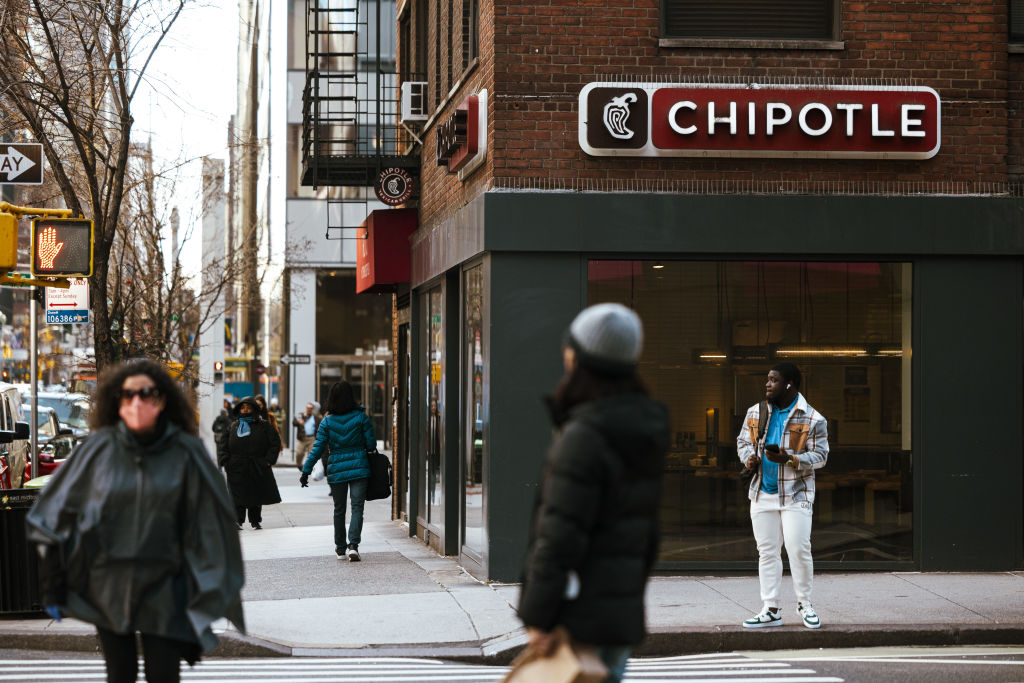What Chipotle Stock's 50-for-1 Split Means for Investors
Chipotle stock will start trading on a split-adjusted basis ahead of Wednesday's open.


Chipotle Mexican Grill (CMG) has given long-term investors plenty to cheer about. Over the past 15 years, Chipotle stock has averaged an annual gain of 28%, easily outpacing the S&P 500's 14.8% total return (price change plus dividends). And the burrito chain's next move could encourage a new crop of folks to look CMG's way.
After the close on Tuesday, June 25, Chipotle underwent a massive 50-for-1 stock split. And CMG stock will begin trading on a post-split basis at the open on Wednesday, June 26.
This marks the first stock split for CMG and one of the biggest in the history of the New York Stock Exchange (NYSE). The split "will make our stock more accessible to employees as well as a broader range of investors," Jack Hartung, chief financial officer of Chipotle, said when the news was first announced back in March. "This split comes at a time when our stock is experiencing an all-time high driven by record revenues, profits, and growth."

Sign up for Kiplinger’s Free E-Newsletters
Profit and prosper with the best of expert advice on investing, taxes, retirement, personal finance and more - straight to your e-mail.
Profit and prosper with the best of expert advice - straight to your e-mail.
Indeed, in its first-quarter earnings report, Chipotle disclosed 14.1% year-over-year revenue growth to $2.7 billion. Earnings surged 37% to $13.37 per share. For the second quarter, analysts expect revenue to jump 16% and earnings per share to rise by 23%.
What does the Chipotle stock split mean?
As for Chipotle's stock split, it won't change anything about the company's fundamentals or market valuation. Rather, a stock split is similar to making change. In CMG's case, it will be equivalent to breaking a $50 bill into 50 $1 bills.
Based on CMG's June 25 close at $3,283, the 50-for-1 stock split will bring the share price to a little over $66. This should make it much more attractive for retail investors, as well as Chipotle employees participating in the company's stock purchase plan, who are unable to buy CMG stock at its four-figure share price.
Walmart (WMT) underwent a similar stock split earlier this year. The retailer cited the importance of keeping its "share price in a range where purchasing whole shares, rather than fractions, was accessible to all of our associates" as the reason behind its 3-for-1 stock split.
Nvidia (NVDA) also split its stock recently, while fellow chipmaker Broadcom (AVGO) also announced a major stock split in its fiscal second-quarter earnings report.
Wall Street says Chipotle stock's still a buy
After the news initially broke, Deutsche Bank analyst Lauren Silberman reiterated her Buy rating on Chipotle stock. "CMG has been among the best-performing restaurant stocks and we expect fundamental strength to continue to drive outperformance," Silberman writes in a note to clients.
The analyst adds that she has high conviction in Chipotle's near- and long-term growth outlooks. She believes "a premium multiple is warranted, noting there is scarcity value for a high-quality U.S. company with a clean balance sheet, strong fundamentals and potential upside to numbers."
Silberman is hardly alone in her bullish outlook toward the consumer discretionary stock. Of the 35 analysts covering Chipotle stock tracked by S&P Global Market Intelligence, 21 say it's a Strong Buy, two have it at Buy, 11 rate it a Hold and one has it at Strong Sell. This works out to a consensus Buy rating and with high conviction.
Related Content
Get Kiplinger Today newsletter — free
Profit and prosper with the best of Kiplinger's advice on investing, taxes, retirement, personal finance and much more. Delivered daily. Enter your email in the box and click Sign Me Up.

With over a decade of experience writing about the stock market, Karee Venema is the senior investing editor at Kiplinger.com. She joined the publication in April 2021 after 10 years of working as an investing writer and columnist at a local investment research firm. In her previous role, Karee focused primarily on options trading, as well as technical, fundamental and sentiment analysis.
-
 Which Stores Are Closing (and Which Aren’t) for Easter 2025?
Which Stores Are Closing (and Which Aren’t) for Easter 2025?Dozens of major retailers are planning to close their doors on April 20. Find out which of your go-to stores are on the list.
By Rachael Green Published
-
 What 401(k) Savers Near Retirement Can Do Amid Market Volatility
What 401(k) Savers Near Retirement Can Do Amid Market VolatilityWhether retirement is years away, a year or two out, or in the rearview mirror, here's how to handle uncertainty in your 401(k).
By Donna Fuscaldo Published
-
 Home Insurance: How to Cut Costs Without Losing Coverage
Home Insurance: How to Cut Costs Without Losing CoverageNatural disasters are causing home insurance premiums to soar, but don't risk dropping your coverage completely when there are ways to keep costs down.
By Jared Elson, Investment Adviser Published
-
 Markets Roller Coaster: Resist the Urge to Make Big Changes
Markets Roller Coaster: Resist the Urge to Make Big ChangesYou could do more harm than good if you react emotionally to volatility. Instead, consider tax-loss harvesting, Roth conversions and how to plan for next time.
By Frank J. Legan Published
-
 Why Homeowners Insurance Has Gotten So Very Expensive
Why Homeowners Insurance Has Gotten So Very ExpensiveThe home insurance industry is seeing more frequent and bigger claims because of weather, wildfires and other natural disasters.
By Karl Susman, CPCU, LUTCF, CIC, CSFP, CFS, CPIA, AAI-M, PLCS Published
-
 Stock Market Today: Uncertainty Proliferates: Dow Loses 1,014 Points
Stock Market Today: Uncertainty Proliferates: Dow Loses 1,014 PointsWeaker-than-expected consumer inflation data wasn't enough to stabilize sentiment during another volatile day for financial markets.
By David Dittman Published
-
 Going Through Probate? How to Find the Right Attorney
Going Through Probate? How to Find the Right AttorneyJust having the skills and experience to do the job isn't enough. The probate attorney you hire needs to have the right temperament for your particular case.
By John R. Silva, Esq. Published
-
 Widow's Penalty: Three Ways to Protect Your Finances
Widow's Penalty: Three Ways to Protect Your FinancesHigher Medicare premiums, smaller Social Security payments, bigger tax bills … Financial changes can hit hard when a spouse dies. How to counter the blow.
By Ashley Terrell, IAR Published
-
 Four Ways Your Phone Can Help You Weather Market Volatility
Four Ways Your Phone Can Help You Weather Market VolatilitySmartphone apps can help investors make healthy decisions and maintain a disciplined investment approach — even when emotions try to steer them off course.
By Marco De Freitas Published
-
 Stock Market Today: Tariff Pause Triggers 3,000-Point Dow Rally
Stock Market Today: Tariff Pause Triggers 3,000-Point Dow RallyThe bond market is sending concerning signals as the Trump administration executes its rapid reordering of global trade relationships.
By David Dittman Published